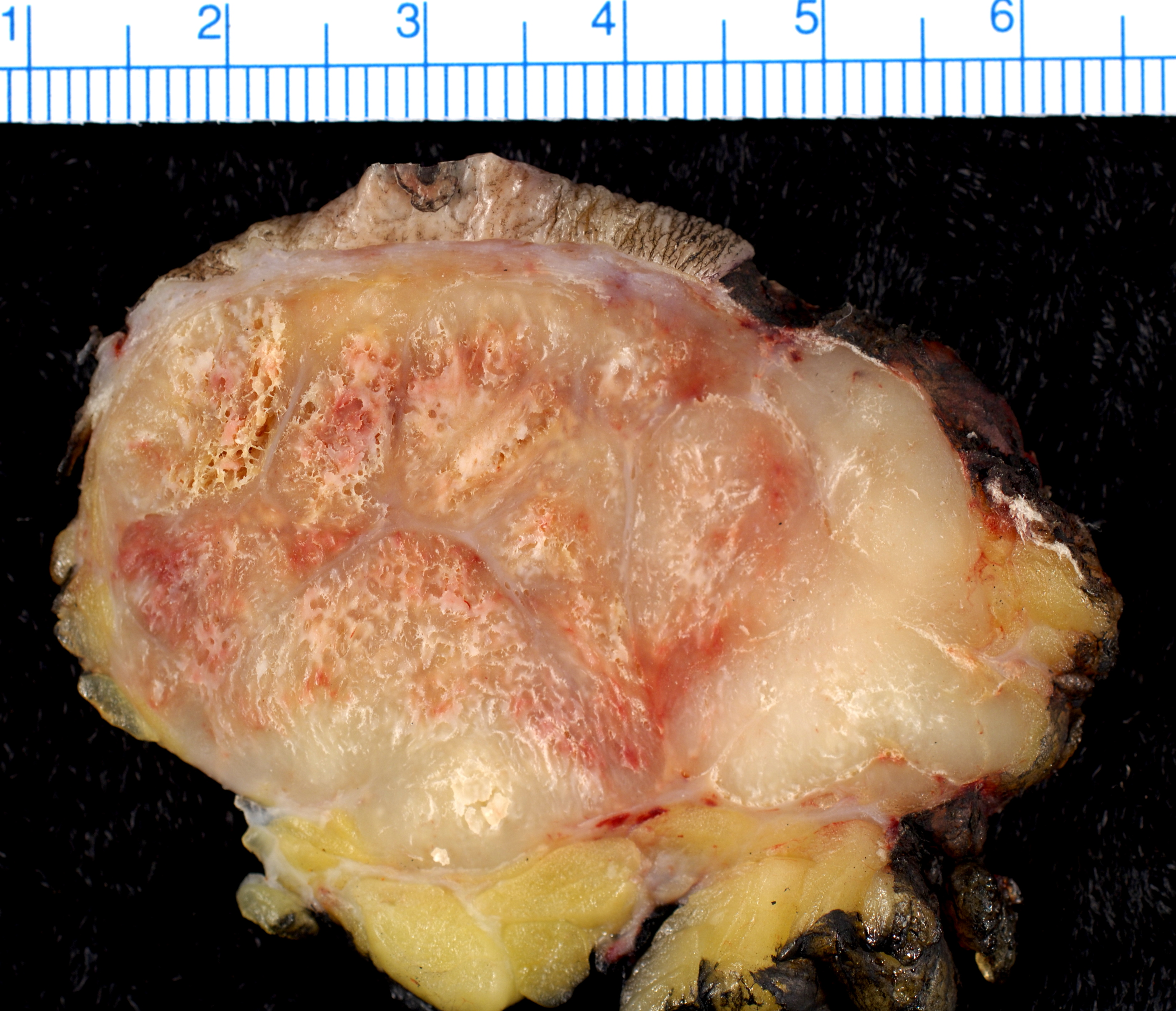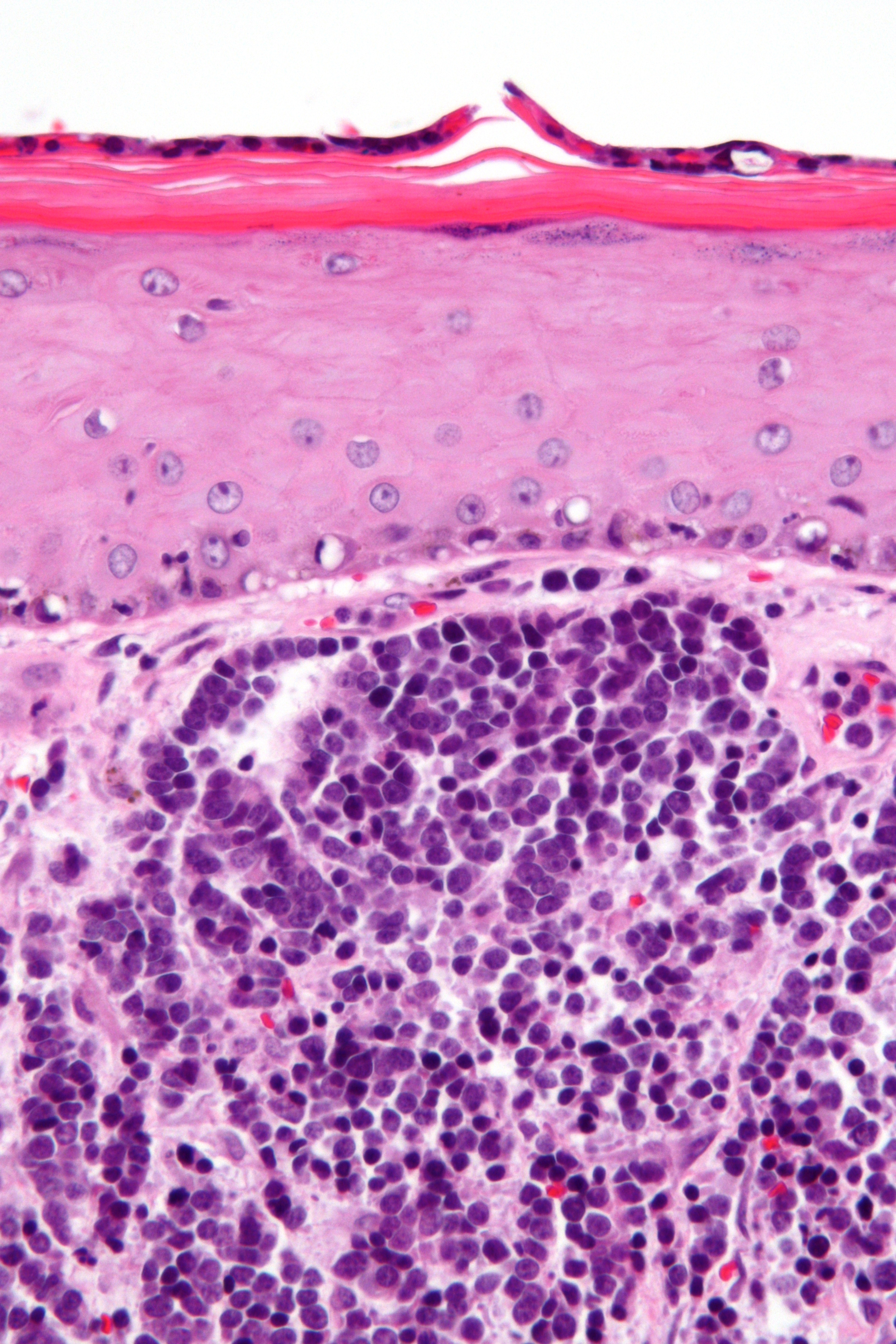Merkel cell cancer pathophysiology
|
Merkel cell cancer Microchapters |
|
Diagnosis |
|---|
|
Treatment |
|
Case Studies |
|
Merkel cell cancer pathophysiology On the Web |
|
American Roentgen Ray Society Images of Merkel cell cancer pathophysiology |
|
Risk calculators and risk factors for Merkel cell cancer pathophysiology |
Overview
Merkel cell carcinoma (MCC) is an unusual cutaneous malignancy of neuroendocrine origin.Merkel nerve endings are mechanoreceptors in the skin.Merkel cells are normal components in the basal layer of the epidermis of the skin.
Pathophysiology
Physiology
The normal physiology of merkel cells can be understood as follows:[1]
- Merkel nerve ending are large, pale cells which function as mechanoreceptors in the skin.
- Merkel cells are usually derived from ectoderm and can be found in the mucosa and basal layer of the epidermis on the skin.
- Neuropeptides which are an integral part of cytoskeletal filaments can be positive for merkel cells.
- Large population of merkel cells can be found in the nerve terminal.
- The presence of merkel cells in the glabrous skin can be called as touch corpuscles and they function as mechanoreceptors.
Pathogenesis
- It is understood that merkel cell cancer is the result caused by either merkel cell polyomavirus, ultraviolet (UV), radiation exposure and immunosuppression.
Merkel cell polyomavirus
- Out of 14 different strains of human polyomaviruses species, MCPyV(merkel cell polyomavirus) is know to cause merkel cell carcinoma in approximately 80% of the patients.[2][3][4]
- Merkel cell polyomavirus belongs to DNA virus which has no envelop and it is double stranded.
- According to new research, specific deletion in the VP1 gene on MCPyV(merkel cell polyomavirus) may lead to merkel cell carcinoma.[5]
- Large T antigen were found to be associated with MCPyV and development of merkel cell carcinoma.
- It is thought that MCPyV(merkel cell polyomavirus) is a normal flora of the skin and sheds chronically.[6]
- Two major oncoproteins were encoded by MCPyV(merkel cell polyomavirus):
- Both large tumor (LT) antigen and small tumor (ST) antigen believed to be play a crucial role in the development of merkel cell carcinoma.
- MCPyV(merkel cell polyomavirus) pathogenesis in sequential order:
- Integration of viral genome into the host genome.
- Increased expression of small tumor (ST) antigen after integration.
- Gaining of mutations in the 3 end of large tumor (LT) antigen which results in the production of truncated molecule.
- And finally evade the immune response by the body.
UV radiation
- It is understood that merkel cell carcinoma is also caused by ultraviolet (UV) radiation exposure.[7][8]
- Exposure to sun is one of the major source of ultraviolet (UV) radiation especially UVB.
- The risk of developing merkel cell carcinoma increases in fair skin individuals.[9]
- Incidence is directly proportional to sun exposure in developing merkel cell carcinoma.[10]
- Patients who are undergoing PUVA therapy have an inceased risk of developing merkel cell carcinoma.
- The exact pathogenesis of how ultraviolet (UV) radiation exposure leads to merkel cell carcinoma is not completely understood.
Immunosuppression
- Patients who underwent organ transplant are also very prone to developing merkel cell carcinoma due to immunosuppression.
- Patients who are suffering with HIV and malignancies especially B cell origin are also likely prone to develop merkel cell carcinoma due to immunosuppression.
- The exact pathogenesis of how immunosuppression leads to merkel cell carcinoma is not completely understood.
Genetics
Genes involved in the pathogenesis of merkel cell carcinoma include:
Gross Pathology
On gross pathology of merkel cell carcinoma

Microscopic Pathology
On microscopic histopathological analysis, trabecular pattern, monotonous round tumor cells, mitotic figures, atypical fibroxanthoma-like areas and dusty chromatin are characteristic findings of merkel cell carcinoma.

References
- ↑ Halata, Zdenek; Grim, Milos; Bauman, Klaus I. (2003). "Friedrich Sigmund Merkel and his ?Merkel cell?, morphology, development, and physiology: Review and new results". The Anatomical Record. 271A (1): 225–239. doi:10.1002/ar.a.10029. ISSN 0003-276X.
- ↑ Feng H, Shuda M, Chang Y, Moore PS (February 2008). "Clonal integration of a polyomavirus in human Merkel cell carcinoma". Science. 319 (5866): 1096–100. doi:10.1126/science.1152586. PMC 2740911. PMID 18202256.
- ↑ Sharp CP, Norja P, Anthony I, Bell JE, Simmonds P (February 2009). "Reactivation and mutation of newly discovered WU, KI, and Merkel cell carcinoma polyomaviruses in immunosuppressed individuals". J. Infect. Dis. 199 (3): 398–404. doi:10.1086/596062. PMID 19090778.
- ↑ Carter JJ, Paulson KG, Wipf GC, Miranda D, Madeleine MM, Johnson LG, Lemos BD, Lee S, Warcola AH, Iyer JG, Nghiem P, Galloway DA (November 2009). "Association of Merkel cell polyomavirus-specific antibodies with Merkel cell carcinoma". J. Natl. Cancer Inst. 101 (21): 1510–22. doi:10.1093/jnci/djp332. PMC 2773184. PMID 19776382.
- ↑ Kassem A, Schöpflin A, Diaz C, Weyers W, Stickeler E, Werner M, Zur Hausen A (July 2008). "Frequent detection of Merkel cell polyomavirus in human Merkel cell carcinomas and identification of a unique deletion in the VP1 gene". Cancer Res. 68 (13): 5009–13. doi:10.1158/0008-5472.CAN-08-0949. PMID 18593898.
- ↑ Schowalter RM, Pastrana DV, Pumphrey KA, Moyer AL, Buck CB (June 2010). "Merkel cell polyomavirus and two previously unknown polyomaviruses are chronically shed from human skin". Cell Host Microbe. 7 (6): 509–15. doi:10.1016/j.chom.2010.05.006. PMC 2919322. PMID 20542254.
- ↑ Heath M, Jaimes N, Lemos B, Mostaghimi A, Wang LC, Peñas PF, Nghiem P (March 2008). "Clinical characteristics of Merkel cell carcinoma at diagnosis in 195 patients: the AEIOU features". J. Am. Acad. Dermatol. 58 (3): 375–81. doi:10.1016/j.jaad.2007.11.020. PMC 2335370. PMID 18280333.
- ↑ Miller RW, Rabkin CS (February 1999). "Merkel cell carcinoma and melanoma: etiological similarities and differences". Cancer Epidemiol. Biomarkers Prev. 8 (2): 153–8. PMID 10067813.
- ↑ Agelli M, Clegg LX (November 2003). "Epidemiology of primary Merkel cell carcinoma in the United States". J. Am. Acad. Dermatol. 49 (5): 832–41. doi:10.1067/S0190. PMID 14576661.
- ↑ Girschik J, Thorn K, Beer TW, Heenan PJ, Fritschi L (November 2011). "Merkel cell carcinoma in Western Australia: a population-based study of incidence and survival". Br. J. Dermatol. 165 (5): 1051–7. doi:10.1111/j.1365-2133.2011.10493.x. PMID 21711338.